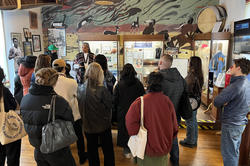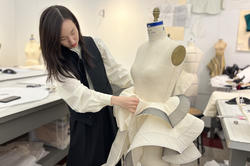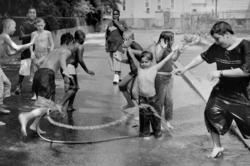Many Hands, Many Voices: Textile Histories and Entanglements, taught by RISD Museum curator Kate Irvin, highlights marginalized makers of the past.
RISD Textiles Students Weave Personal Narratives
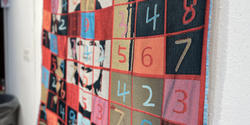
This semester, 14 Textiles students are learning to weave on a large scale in Jacquard Design, a studio taught by faculty member Siena Smith 18 TX. Throughout the fall, students will learn how to use the recently installed state-of-the-art Jacquard loom, while also considering the complex history of weaving.
“Within the textiles industry, there is so much erasure and appropriation of handwoven techniques from other cultures,” says Smith. “The industrialization of weaving capitalized on Europeans taking designs and resources from Black, Brown and Indigenous people of color. In this class, students are learning the history of the brutality related to the weaving industry, as well as the nurturing of weaving and textile arts within our communities.”
The studio has long been a mainstay of RISD’s Textiles curriculum, but this fall students are taking advantage of the newer, larger Jacquard loom that was installed in RISD’s Metcalf Building last summer. On the new machine, weavers can create pieces up to 54 inches wide and will no longer be confined to designing patterns that will repeat four times—a requirement of the previous loom. “Having a full weaving width with no repeat opens additional possibilities,” explains Smith. “Their work no longer has to be engineered for design purposes.”
“The Jacquard loom, an early precursor to computers, has evolved significantly with modern technology,” says Department Head Anna Gitelson-Kahn MFA 09 TX. “This new equipment can control over 8,000 individual threads at once and generate a massive singular image. It's a real pinnacle for our weaving program that builds upon a legacy of innovation and discovery in advanced weaving at RISD that spans decades.” Gitelson-Kahn worked on the project with former Department Head Mary Anne Friel, then-Provost Anais Missakian 84 TX, Dean of Fine Arts Brooks Hagan MFA 06 TX and Textiles technician Polly Spenner 10 TX.
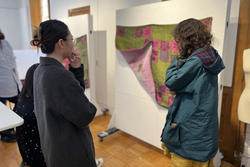
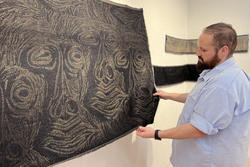
“It’s amazing to see how the students are breaking down their individual experiences into cloth.”
At a mid-semester critique in the College Building, students share their designs with the group, all of which relate to the artists’ personal experiences. Em Kapp 24 TX hangs up two pieces with bright green backdrops, pink squares and the silhouette of a single horse in the corner. “I think you can play with reorganization,” says Smith. “There’s already directionality, but showing the back really adds to that.”
Kapp’s classmate, Christopher Beaudoin 24 TX, suggests adding the image of a rocking horse to give the piece a more childlike essence. “This feels so luscious,” he says as he runs his hand across the green fabric, “almost like grass. I’ve never seen floats like this on a quilt before.”
Later, Beaudoin shares a piece made of mohair, cotton and linen, which features black and gold colors and long, abstracted faces. “I studied ceramics in Hungary and was sad and homesick while I was there, so I created this piece about depression,” he explains. “I’m planning to attach Swarovski crystals to serve as tears under the eyes. I want to keep going with this piece over the course of the semester.”
Across the room hangs a brightly colored quilt by Xiao Guo 24 TX (see top photo), which features a red grid of numbers atop a woman’s face. “I put an image of my mother and Sudoku numbers in the weave,” Guo explains. “I think the color scheme is very playful.” Other images appear scattered throughout the quilt, including an illustration of a small bird wearing a crown.
Guo’s peers are captivated by the piece. “It has a timeless quality,” says one. “These are clever ways of working with images. It feels very intentional.”
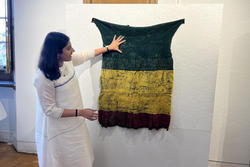
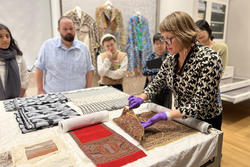
Next, Yukti Agarwal BRDD 24 TX pulls out a smaller yellow, red and green geometric piece made with wool, cotton and linen. “I used to take walks during the pandemic, so I combined my routes to make a map,” she explains. “I’m being very intentional with my knits, but I’m still figuring out my approach to wovens.”
Smith comments on the intuitive nature of Agarwal’s process. “I think it’s really cool when the purple comes up through the wool,” she adds. “And I’m enjoying how you’re changing up the materials.”
Afterwards, students head to the RISD Museum for a look into the Donghia Costumes and Textiles Collection with Curator and Head of Costume & Textiles Kate Irvin. Irvin has everything from a tapestry-woven shawl to a wearable tunic made with a Japanese double weave laid out on the table. She also shows Tree on Frame, a Jacquard design by Dutch maker Hil Driessen, which features a tree that was stitched into vinyl and then photographed and translated onto linen, cotton and foam.
The class studies each piece closely before heading back to the studio to continue working on their own designs. “You can see how they are thinking about weave structures, texture, scale, surface and imagery,” Smith says, “and how that relates to their ideas and questions. They’re all approaching the work differently. It’s amazing to see how the students are breaking down their individual experiences into cloth.”
Isabel Roberts / Top image work by Xiao Guo
November 27, 2023
